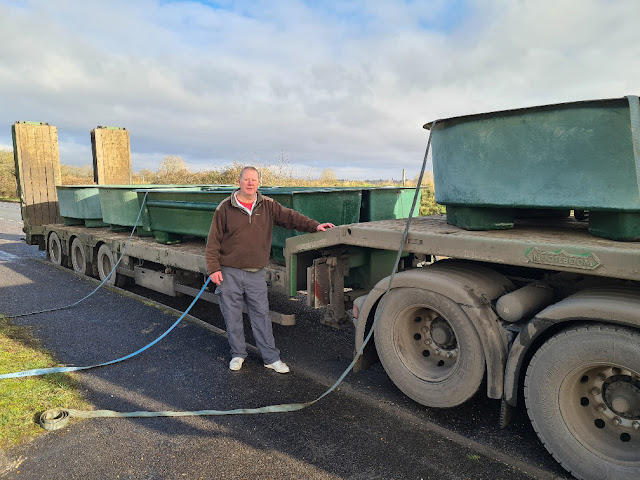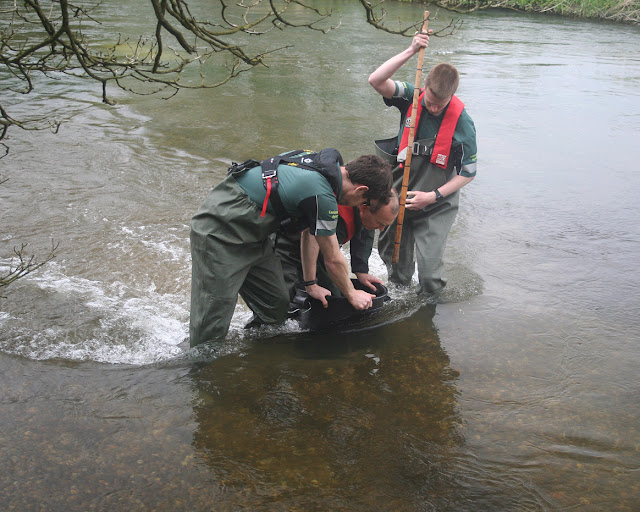It’s been a strange year of wildly contrasting
emotions without Budgie. Still, he continues to inspire and is in our hearts
and thoughts, and our laughs and smiles, every single day as the Avon Roach
Project legacy lives on. Our Avon roach continue to flourish with, not only
eyewatering numbers and sizes but equally importantly, healthy numbers of
little ‘uns showing throughout the river, meaning they are continuing to reproduce
and survive in sufficient numbers and are naturally holding their own, which
was the whole idea.
In addition to this we now also have the gathering
interest and impact both here and on other rivers of our barbel gravel spawning
substrate enhancement scheme which, despite being hampered by conditions, saw
us out again earlier in the year.
And while the river continues its assisted recovery,
so too does Project HQ as it slowly returns to being my garden with the removal
of some of the tanks.
The removal of the first five of the remaining nine
tanks stimulated a morning of very poignant and strangely profound emotions. Apart
from an obvious relief at finally getting a large lump of my garden back, there
was a sense of closure, but balanced with an enormous sense of accomplishment
these tanks had enabled by being home, every year for more than a decade, to
literally tens of thousands of precious Avon Roach.
Unquestionably, the overriding emotion on the day
was sadness at Budgie not being there conducting affairs. This was a
significant ending and beginning of another chapter in the amazing Avon Roach
Project story, and the first to be missed by Budgie who would have been
wrapped, almost mummified, against the cold but been front and centre for every
second. And, just as he offered to get in the river with us to rake the barbel
gravels last year, but only up to his knees, he said, so I know he’d have jokingly
offered to get a corner of each tank for loading onto the lorry. Although
absent in body, he was with us in spirit and, I’m sure, taking the piss out of
me… Bastard!
The tanks were taken to pastures new by the EA guys,
on the biggest low-loader I’d ever seen… Two million tons and at least four
miles long, I reckon. And, in my head, I could clearly hear Budgie say to the driver
‘Let’s have a drive of your lorry mate.’
Four of the five tanks had been situated right in
the middle of the lower garden, as you can see in the pictures below, so rather
than return it to lawn, as it had been, then resume bitching about having to mow
it every few weeks, I decided that, in memory of Budg’ and the thousands of
Avon roach that had occupied the space over the years, I’d sow wild flowers on
the bare patches left by the tanks from the seed-mix Budgie had recommended and
had grown in his own garden. The pictures below tell the story, with the final
few images showing an additional shared and permanent symbolic nod to the great
man.
I’ve also included some memorable archive pictures
that span the tanks entire life in our care as a reminder of what ended up far
exceeding the original ‘roach in a bathtub’ concept.
So, to the latest Avon Roach Project activities, the
ongoing barbel gravel spawning substrate enhancement scheme – we really need to
come up with a shorter title; and this year, as last, we selected three more
sites for our attentions.
The timing of this is critical and we have a small
window of opportunity each year, partly to get the maximum benefit from the
desilted gravel for the imminent spawners but also enough time for
recolonisation of the vital invertebrate food source for the barbel larvae,
particularly as they spend longer in the loosened gravel than other species,
while considering any impact on the other things that might be affected by what
we do and when. Despite a fair chance of favourable conditions at this time of
year, we are still at the mercy of the weather and river.
The roach had started spawning right on time in a
slightly high and coloured river at the end of April so we were hopeful.
However, it didn’t turn out as planned, in more ways
than one.
First stop was to be a day at the famous Royalty
fishery in Christchurch with new keeper, Dan; but the river remained just too
high for safe access to the two spawning areas we’d planned on doing, so we
reluctantly cancelled and have it at the top of the list for next year.
Next it was the area above the once prolific Severals,
on Christchurch Angling Club controlled Ringwood fishery, which was pushing
through, but did allow us to not only significantly desilt a vast area of
gravels – the upper area of a known spawning site, but also take some very
revealing before and after sediment samples, which we plan on doing
periodically throughout the year, as well as linking in with some new and
historical invertebrate sampling through the EA.
Many assume that just a bit of a flush naturally
cleans the gravel, which it does at first glance but, unless thunderous, it
simply brushes the organic dusty silt and algae from the surface, leaving the
heavier compacted sediment where it is. You can see the differences in sediment
weight and density in the closeup picture below… Sorry it’s not as interesting
as our old roachy pictures.
The sediment samples are all taken from a litre of
water taken from a critically controlled volume of disturbed gravel, also seen
in the pictures below. The difference was quite remarkable and even from a
single activity like our raking, it was very clear we were having a significant
impact. We pondered the huge volume of silt we’d disturbed equating to the
space now available to be filled with barbel eggs. No brainer, really.
Then on to a middle river spot pinpointed by a keen
supporter within the bankside Game and Wildlife Conservation Trust just north
of Fordingbridge controlled by Salisbury and District AC.
Unfortunately, very likely caused by the same
erosion and run-off, plus the cattle poaching we highlighted in our original
blog post when we started this initiative, responsible
for years of buildup of fine sandy substrate and organic deposits, the gravel
refused the attentions of our raking, no matter how much shoulder-power was
used. It sounded like the rakes were being dragged across concrete. Although
glowing golden yellow after the high water, it was impermeable and pavement
hard.
Unfortunately, this, just as some other areas we
have assessed have already shown they are in need of far more robust attention.
We have decided the only way to achieve what we need here is to do it with
pumped water through powerful jets; an old method historically used for salmon
and trout redds, and one we have in our own armoury.
Another, more substantial and permanent option here would
be to hinge and stake a nearby willow (which will remain living) across the
upper area to create a flush of water to scour and oxygenate the spawning
gravels; another tried and trusted undertaking in general river improvements in
specific cases and something we’ll be looking into with the EA guys who, once
again, with everything we’ve done this year, have been brill…
We want to avoid unnecessary silt displacement and
do just
enough to enhance the pinpoint specific spawning areas. And, as
previously mentioned, we have plans, when conditions are more friendly, to work
on part of an easily observable spawning area to try to establish if the
percolation of water on the underside of the fish stimulates a preference for
the cleaned gravel as we know it does in trout – this may never be established,
but worth a try (bit like our views on roach, which led to some astonishing
discoveries)… Conditions this year made it difficult to spot spawning barbel
but a few were definitely seen over some of the areas we worked on last year.
All our stomping about in a SSSI is, of course,
subject to us obtaining relevant consents, but we managed it with the roach
project, so don’t see a problem, other than the project now lacking Budgie’s
‘charm’…
Just like the old principles of the ARP, we want to
work as sensitively and holistically as we can to simply improve the odds in
the critical natural numbers game by increasing egg survival and fry
recruitment while retaining the existing genetics, something we have always
been extremely vehement about.
It is hoped that in time, there can be an almost
river-wide coordinated annual undertaking, with the right consents and
guidance, by those keepers and angling clubs wishing to take part in helping
improve the river – a bit of ‘citizen science’.
So, over and out for now, and hope you enjoy this
update.
Hopefully the pictures below are good enough to illustrate our efforts.
 |
Several different spots
were sampled, from close to the bank to almost mid-river, and the EA guys
supplied all the equipment and expertise. |
 |
Samples taken and
recorded and we went in with the rakes. We systematically work our way across
the patch we had chosen. Our own ‘Riverdance.’ |
 |
Even in the shallows
you can see the volume of water coming past us. A bit disorientating if you don’t
keep your eye in – especially being as clumsy as me. |
 |
We took sediment
samples after we’d raked for comparison and this picture shows the
effectiveness of our efforts. |
 |
So, to the tank
removal, and the first five to go to their new custodians were these.
Freestanding and easy to re-site. And, although pleased to see the back of ‘em,
it was quite a moment. |
 |
Perfect fit on that
giant truck, and another soppy moment as I am right where Budgie would have
positioned himself for the picture and had his hand resting right where mine is. |
 |
Project HQ at full
capacity. Lids on for shade and protection from airborne predation, pumped and
filtered water and home to unimaginable numbers of Avon Roach. Bloody hard
work, but what a trip… |
 |
Clouds of ‘days old’
tiny vulnerable little roach born into a system that would enable a first year
survival of tens of thousands against less than a handful in the wild from the
same spawn volume. |
 |
Healthy, strong, plump
one year old Avon roach, pictured as they were being evicted from the tanks and
taken to our stew ponds, and still only part of the way through their time in
our care. |
 |
And now, as I sit of an
evening watching the sunset, I raise a beer to Budg’ and the thousands of roach
and the life that now continues in the space they have left. |












Brilliant blog, Trevor, thanks for keeping us up-to-date. Thank you so much for all you've done and are doing. RIP, Budgie.
ReplyDeleteSeen the evidence of the Roach success at Downton.